大学英语写作实践教学
- 格式:doc
- 大小:27.00 KB
- 文档页数:3
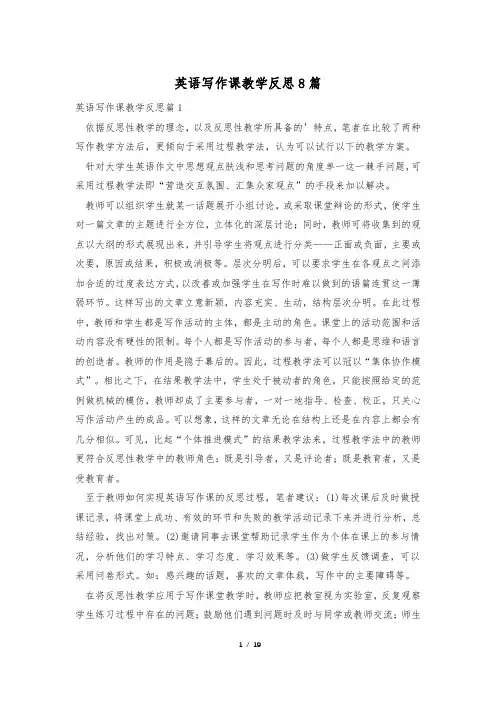
英语写作课教学反思8篇英语写作课教学反思篇1依据反思性教学的理念,以及反思性教学所具备的’特点,笔者在比较了两种写作教学方法后,更倾向于采用过程教学法,认为可以试行以下的教学方案。
针对大学生英语作文中思想观点肤浅和思考问题的角度单一这一棘手问题,可采用过程教学法即“营造交互氛围、汇集众家观点”的手段来加以解决。
教师可以组织学生就某一话题展开小组讨论,或采取课堂辩论的形式,使学生对一篇文章的主题进行全方位,立体化的深层讨论;同时,教师可将收集到的观点以大纲的形式展现出来,并引导学生将观点进行分类——正面或负面,主要或次要,原因或结果,积极或消极等。
层次分明后,可以要求学生在各观点之间添加合适的过度表达方式,以改善或加强学生在写作时难以做到的语篇连贯这一薄弱环节。
这样写出的文章立意新颖,内容充实、生动,结构层次分明。
在此过程中,教师和学生都是写作活动的主体,都是主动的角色。
课堂上的活动范围和活动内容没有硬性的限制。
每个人都是写作活动的参与者,每个人都是思维和语言的创造者。
教师的作用是隐于幕后的。
因此,过程教学法可以冠以“集体协作模式”。
相比之下,在结果教学法中,学生处于被动者的角色,只能按照给定的范例做机械的模仿,教师却成了主要参与者,一对一地指导、检查、校正,只关心写作活动产生的成品。
可以想象,这样的文章无论在结构上还是在内容上都会有几分相似。
可见,比起“个体推进模式”的结果教学法来,过程教学法中的教师更符合反思性教学中的教师角色:既是引导者,又是评论者;既是教育者,又是受教育者。
至于教师如何实现英语写作课的反思过程,笔者建议:(1)每次课后及时做授课记录,将课堂上成功、有效的环节和失败的教学活动记录下来并进行分析,总结经验,找出对策。
(2)邀请同事去课堂帮助记录学生作为个体在课上的参与情况,分析他们的学习特点、学习态度、学习效果等。
(3)做学生反馈调查,可以采用问卷形式。
如:感兴趣的话题,喜欢的文章体裁,写作中的主要障碍等。
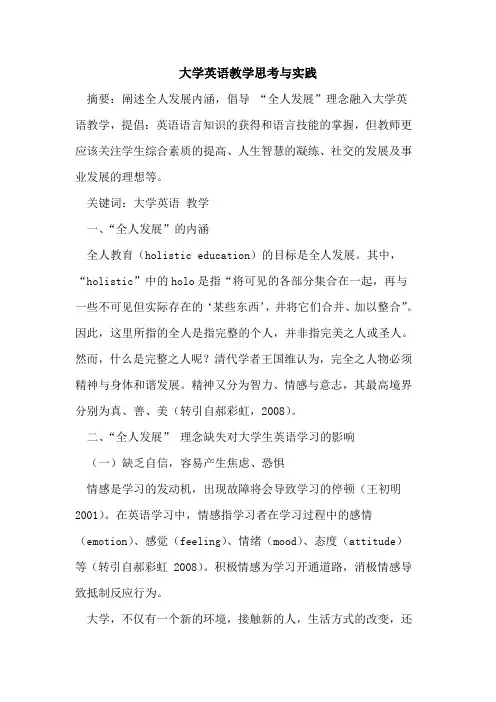
大学英语教学思考与实践摘要:阐述全人发展内涵,倡导“全人发展”理念融入大学英语教学,提倡:英语语言知识的获得和语言技能的掌握,但教师更应该关注学生综合素质的提高、人生智慧的凝练、社交的发展及事业发展的理想等。
关键词:大学英语教学一、“全人发展”的内涵全人教育(holistic education)的目标是全人发展。
其中,“holistic”中的holo是指“将可见的各部分集合在一起,再与一些不可见但实际存在的‘某些东西’,并将它们合并、加以整合”。
因此,这里所指的全人是指完整的个人,并非指完美之人或圣人。
然而,什么是完整之人呢?清代学者王国维认为,完全之人物必须精神与身体和谐发展。
精神又分为智力、情感与意志,其最高境界分别为真、善、美(转引自郝彩虹,2008)。
二、“全人发展”理念缺失对大学生英语学习的影响(一)缺乏自信,容易产生焦虑、恐惧情感是学习的发动机,出现故障将会导致学习的停顿(王初明2001)。
在英语学习中,情感指学习者在学习过程中的感情(emotion)、感觉(feeling)、情绪(mood)、态度(attitude)等(转引自郝彩虹 2008)。
积极情感为学习开通道路,消极情感导致抵制反应行为。
大学,不仅有一个新的环境,接触新的人,生活方式的改变,还必须面对全新的学习方式、思维方式和人际交往形式的挑战。
在大学英语学习方面主要表现为:高中英语教学主要是应试教育,重点是语言知识,而大学英语更注重学生的语言运用能力,强调全面培养学生的听说读写技能。
很多学生因为在高中课堂几乎不用英语发言,平时也很少读英语,英语发音也很烂;进入大学以后,每次上英语课都提心吊胆,唯恐在课堂上出丑,即使准备得再充分,也没有勇气和自信在课堂上表达自己的看法与见解。
长此以往,对学习、人生观、事业观的形成和发展都会造成不利影响。
(二)缺乏自我约束和自我管理能力大学英语课程设置侧重为学生提供更多的自由和选择,要求学生学习更自主、更自觉,逐渐培养出良好的自主学习能力。
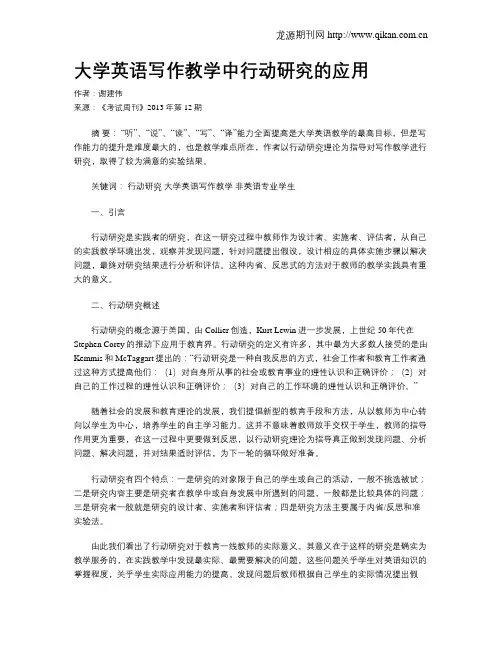
大学英语写作教学中行动研究的应用作者:谢建伟来源:《考试周刊》2013年第12期摘要:“听”、“说”、“读”、“写”、“译”能力全面提高是大学英语教学的最高目标,但是写作能力的提升是难度最大的,也是教学难点所在,作者以行动研究理论为指导对写作教学进行研究,取得了较为满意的实验结果。
关键词:行动研究大学英语写作教学非英语专业学生一、引言行动研究是实践者的研究,在这一研究过程中教师作为设计者、实施者、评估者,从自己的实践教学环境出发,观察并发现问题,针对问题提出假设,设计相应的具体实施步骤以解决问题,最终对研究结果进行分析和评估。
这种内省、反思式的方法对于教师的教学实践具有重大的意义。
二、行动研究概述行动研究的概念源于美国,由Collier创造,Kurt Lewin进一步发展,上世纪50年代在Stephen Corey的推动下应用于教育界。
行动研究的定义有许多,其中最为大多数人接受的是由Kemmis和McTaggart提出的:“行动研究是一种自我反思的方式,社会工作者和教育工作者通过这种方式提高他们:(1)对自身所从事的社会或教育事业的理性认识和正确评价;(2)对自己的工作过程的理性认识和正确评价;(3)对自己的工作环境的理性认识和正确评价。
”随着社会的发展和教育理论的发展,我们提倡新型的教育手段和方法,从以教师为中心转向以学生为中心,培养学生的自主学习能力。
这并不意味着教师放手交权于学生,教师的指导作用更为重要,在这一过程中更要做到反思,以行动研究理论为指导真正做到发现问题、分析问题、解决问题,并对结果适时评估,为下一轮的循环做好准备。
行动研究有四个特点:一是研究的对象限于自己的学生或自己的活动,一般不挑选被试;二是研究内容主要是研究者在教学中或自身发展中所遇到的问题,一般都是比较具体的问题;三是研究者一般就是研究的设计者、实施者和评估者;四是研究方法主要属于内省/反思和准实验法。
由此我们看出了行动研究对于教育一线教师的实际意义。
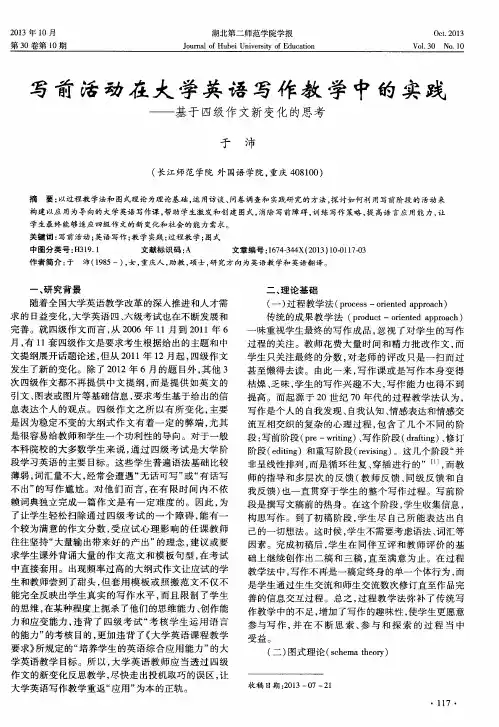

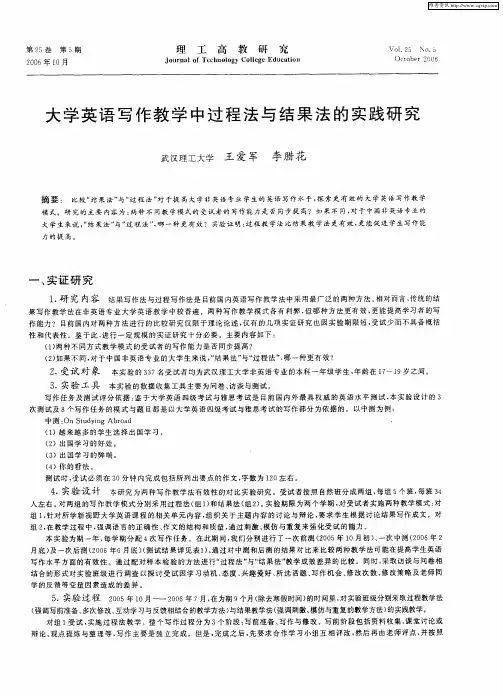
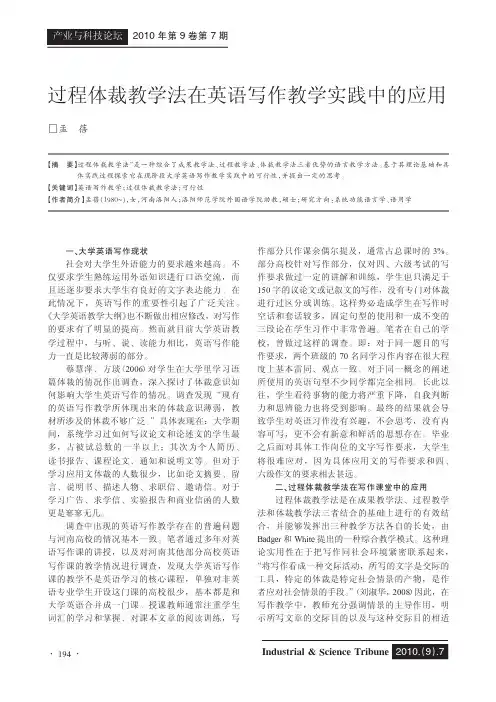
产业与科技论坛2010年第9卷第7期一、大学英语写作现状社会对大学生外语能力的要求越来越高。
不仅要求学生熟练运用外语知识进行口语交流,而且还逐步要求大学生有良好的文字表达能力。
在此情况下,英语写作的重要性引起了广泛关注。
《大学英语教学大纲》也不断做出相应修改,对写作的要求有了明显的提高。
然而就目前大学英语教学过程中,与听、说、读能力相比,英语写作能力一直是比较薄弱的部分。
蔡慧萍、方琰(2006)对学生在大学里学习语篇体裁的情况作出调查,深入探讨了体裁意识如何影响大学生英语写作的情况。
调查发现“现有的英语写作教学所体现出来的体裁意识薄弱,教材所涉及的体裁不够广泛。
”具体表现在:大学期间,系统学习过如何写议论文和论述文的学生最多,占被试总数的一半以上;其次为个人简历、读书报告、课程论文、通知和说明文等。
但对于学习应用文体裁的人数很少,比如论文摘要、留言、说明书、描述人物、求职信、邀请信。
对于学习广告、求学信、实验报告和商业信函的人数更是寥寥无几。
调查中出现的英语写作教学存在的普遍问题与河南高校的情况基本一致。
笔者通过多年对英语写作课的讲授,以及对河南其他部分高校英语写作课的教学情况进行调查,发现大学英语写作课的教学不是英语学习的核心课程,单独对非英语专业学生开设这门课的高校很少,基本都是和大学英语合并成一门课。
授课教师通常注重学生词汇的学习和掌握、对课本文章的阅读训练,写作部分只作课余偶尔提及,通常占总课时的3%。
部分高校针对写作部分,仅对四、六级考试的写作要求做过一定的讲解和训练,学生也只满足于150字的议论文或记叙文的写作,没有专门对体裁进行过区分或训练。
这样势必造成学生在写作时空话和套话较多,固定句型的使用和一成不变的三段论在学生习作中非常普遍。
笔者在自己的学校,曾做过这样的调查。
即:对于同一题目的写作要求,两个班级的70名同学习作内容在很大程度上基本雷同、观点一致、对于同一概念的阐述所使用的英语句型不少同学都完全相同。
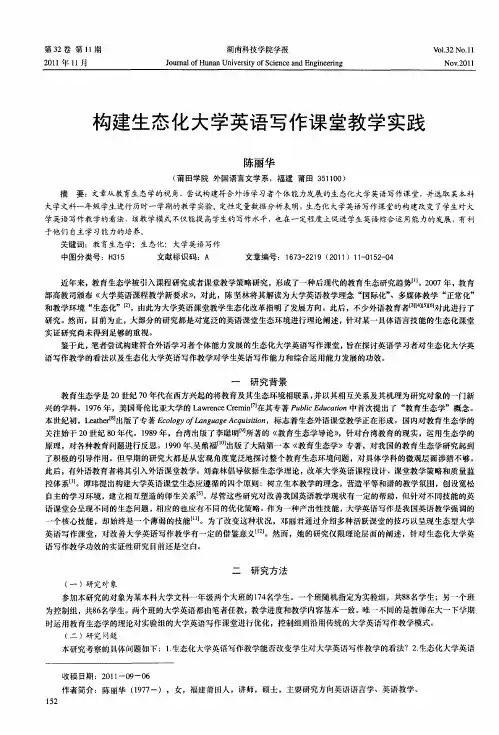
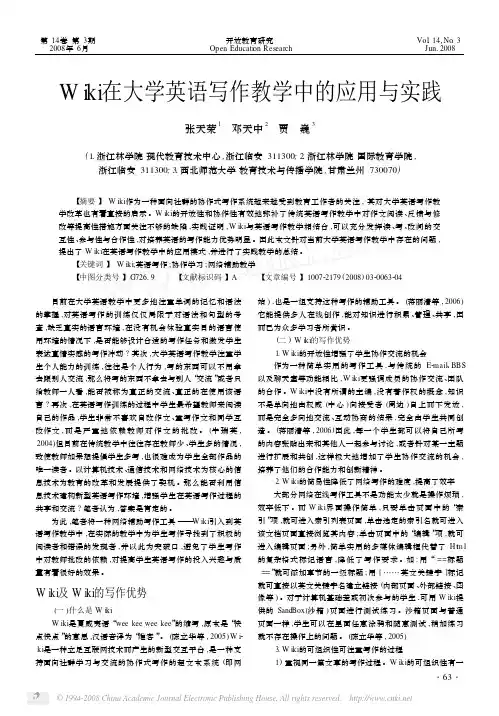
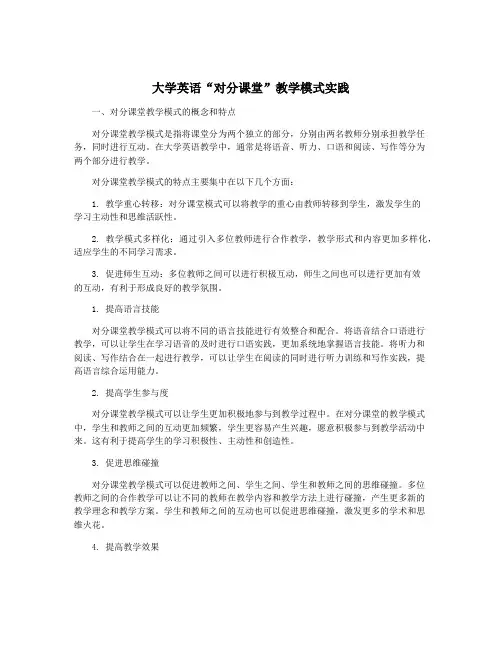
大学英语“对分课堂”教学模式实践一、对分课堂教学模式的概念和特点对分课堂教学模式是指将课堂分为两个独立的部分,分别由两名教师分别承担教学任务,同时进行互动。
在大学英语教学中,通常是将语音、听力、口语和阅读、写作等分为两个部分进行教学。
对分课堂教学模式的特点主要集中在以下几个方面:1. 教学重心转移:对分课堂模式可以将教学的重心由教师转移到学生,激发学生的学习主动性和思维活跃性。
2. 教学模式多样化:通过引入多位教师进行合作教学,教学形式和内容更加多样化,适应学生的不同学习需求。
3. 促进师生互动:多位教师之间可以进行积极互动,师生之间也可以进行更加有效的互动,有利于形成良好的教学氛围。
1. 提高语言技能对分课堂教学模式可以将不同的语言技能进行有效整合和配合。
将语音结合口语进行教学,可以让学生在学习语音的及时进行口语实践,更加系统地掌握语言技能。
将听力和阅读、写作结合在一起进行教学,可以让学生在阅读的同时进行听力训练和写作实践,提高语言综合运用能力。
2. 提高学生参与度对分课堂教学模式可以让学生更加积极地参与到教学过程中。
在对分课堂的教学模式中,学生和教师之间的互动更加频繁,学生更容易产生兴趣,愿意积极参与到教学活动中来。
这有利于提高学生的学习积极性、主动性和创造性。
3. 促进思维碰撞对分课堂教学模式可以促进教师之间、学生之间、学生和教师之间的思维碰撞。
多位教师之间的合作教学可以让不同的教师在教学内容和教学方法上进行碰撞,产生更多新的教学理念和教学方案。
学生和教师之间的互动也可以促进思维碰撞,激发更多的学术和思维火花。
4. 提高教学效果对分课堂教学模式有望提高大学英语教学的效果。
通过不同的教师之间的协作教学,可以更全面地覆盖教学内容,保证教学的全面性和系统性。
多样化的教学方式和形式可以更好地适应学生的学习特点和需求,促进教学效果的最大化。
在推广对分课堂教学模式时,需要进行针对性的探索和实践。
需要结合大学英语的教学特点,明确对分课堂教学模式的实践路径。
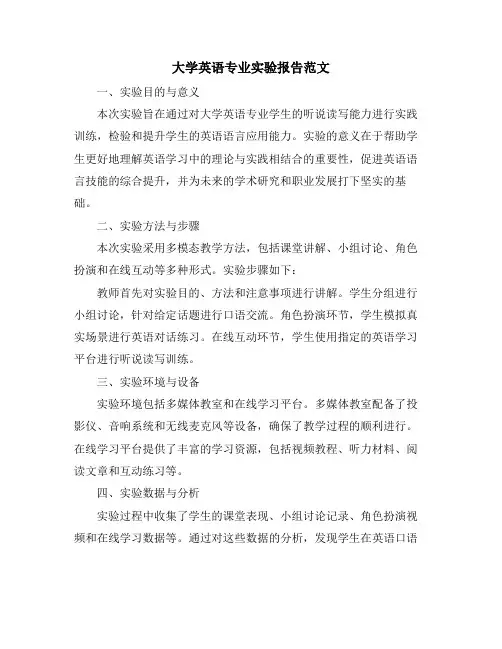
大学英语专业实验报告范文一、实验目的与意义本次实验旨在通过对大学英语专业学生的听说读写能力进行实践训练,检验和提升学生的英语语言应用能力。
实验的意义在于帮助学生更好地理解英语学习中的理论与实践相结合的重要性,促进英语语言技能的综合提升,并为未来的学术研究和职业发展打下坚实的基础。
二、实验方法与步骤本次实验采用多模态教学方法,包括课堂讲解、小组讨论、角色扮演和在线互动等多种形式。
实验步骤如下:教师首先对实验目的、方法和注意事项进行讲解。
学生分组进行小组讨论,针对给定话题进行口语交流。
角色扮演环节,学生模拟真实场景进行英语对话练习。
在线互动环节,学生使用指定的英语学习平台进行听说读写训练。
三、实验环境与设备实验环境包括多媒体教室和在线学习平台。
多媒体教室配备了投影仪、音响系统和无线麦克风等设备,确保了教学过程的顺利进行。
在线学习平台提供了丰富的学习资源,包括视频教程、听力材料、阅读文章和互动练习等。
四、实验数据与分析实验过程中收集了学生的课堂表现、小组讨论记录、角色扮演视频和在线学习数据等。
通过对这些数据的分析,发现学生在英语口语和听力方面的表现较为突出,但在阅读和写作方面还存在一定的不足。
五、实验结果与讨论经过为期一个学期的实验,学生的英语综合应用能力得到了显著提高。
在口语和听力方面,学生能够更加流利地进行英语交流,并能够更好地理解英语材料。
在阅读和写作方面,学生的进步虽然明显,但仍需进一步加强训练。
同时,实验还发现,多模态教学方法能够激发学生的学习兴趣和积极性,提高学习效果。
六、实验反思与改进在实验过程中,我们发现在线学习平台的互动性和个性化学习方面还有待提升。
未来可以考虑增加更多的互动功能,如智能推荐、实时反馈等,以满足不同学生的学习需求。
此外,还应加强对学生阅读和写作能力的培养,通过增加相关练习和辅导来提高他们的技能水平。
七、结论与建议本次实验表明,多模态教学方法对提升大学英语专业学生的英语应用能力具有积极作用。
第1篇日期:2023年4月10日一、今日工作概述今日教学工作主要集中在《大学英语》课程上,主要内容包括课堂讲授、小组讨论、写作练习等。
以下为具体工作内容:二、具体工作内容1. 课堂讲授(1)课前准备:根据教学计划,提前准备好PPT课件、教学案例等教学资源,确保课堂内容丰富、生动。
(2)课堂实施:采用互动式教学方法,引导学生积极参与课堂讨论。
针对课程重点、难点,进行详细讲解,确保学生掌握知识要点。
(3)课后反思:针对今日讲授内容,总结教学效果,发现不足之处,为今后教学提供改进方向。
2. 小组讨论(1)分组:将学生分成若干小组,每组4-5人,确保组内成员具有一定的语言基础。
(2)讨论主题:针对课文内容,设定讨论主题,如:文化差异、语言表达等。
(3)讨论过程:引导学生围绕主题展开讨论,鼓励学生积极发言,分享自己的观点和看法。
(4)总结与反馈:每组派代表进行总结发言,教师针对学生的讨论情况进行点评,指出优点与不足。
3. 写作练习(1)写作要求:根据课文内容,布置一篇写作练习,要求学生运用所学知识,结合自身实际,撰写一篇短文。
(2)写作指导:针对写作要求,进行详细讲解,指导学生如何组织文章结构、运用语言表达等。
(3)写作过程:学生独立完成写作任务,教师巡视课堂,解答学生在写作过程中遇到的问题。
(4)批改与反馈:教师批改学生作文,针对文章内容、结构、语言等方面进行点评,提出改进建议。
三、今日工作总结1. 教学效果:今日课堂气氛活跃,学生积极参与讨论,写作练习完成度较高。
2. 教学反思:(1)课堂讲授方面:在讲解过程中,注重与学生的互动,提高学生的参与度。
但部分学生对课程内容理解不够深入,需要进一步改进教学方法。
(2)小组讨论方面:学生在讨论过程中,能够积极发言,但部分学生表达不够清晰,需要加强口语表达能力的培养。
(3)写作练习方面:学生在写作过程中,能够运用所学知识,但部分学生文章结构不够完整,需要加强写作技巧的培养。
第1篇一、引言随着全球化进程的不断加快,英语作为国际通用语言的重要性日益凸显。
为了提高学生的英语综合应用能力,我校英语专业特开展了综合英语实践教学活动。
本次实践活动旨在通过多种教学手段和形式,帮助学生提升听、说、读、写、译等英语技能,增强跨文化交际意识,培养具备国际视野的应用型人才。
二、实践内容与过程(一)实践内容1. 听力训练:通过播放英语电影、新闻、演讲等素材,提高学生的听力理解能力。
2. 口语表达:组织模拟对话、角色扮演、小组讨论等活动,锻炼学生的口语表达能力。
3. 阅读理解:选取不同题材的英语文章,引导学生进行深入阅读,提高阅读速度和理解能力。
4. 写作训练:指导学生撰写英语短文、作文,培养良好的写作习惯和技巧。
5. 翻译实践:进行中英文互译练习,提高学生的翻译能力。
6. 跨文化交际:通过案例分析、文化讲座等形式,帮助学生了解不同国家的文化背景,提高跨文化交际能力。
(二)实践过程1. 前期准备:教师根据教学大纲和学生的实际情况,制定详细的实践教学计划,并准备相应的教学素材。
2. 课堂实施:教师通过多样化的教学方法,引导学生积极参与实践活动,并及时给予指导和反馈。
3. 课后拓展:鼓励学生利用课余时间进行自主学习,如观看英语电影、阅读英文原著等。
4. 成果展示:定期举办英语角、英语演讲比赛等活动,为学生提供展示自我、交流学习的平台。
三、实践成果与反思(一)实践成果1. 学生英语综合能力得到显著提升:通过实践活动,学生的听、说、读、写、译等英语技能均有所提高,尤其是口语和写作能力得到了明显加强。
2. 跨文化交际意识增强:学生通过了解不同国家的文化背景,增强了跨文化交际意识,提高了在多元文化环境中的适应能力。
3. 自主学习能力提高:实践活动激发了学生的学习兴趣,培养了学生的自主学习能力。
(二)反思与改进1. 教学手段需进一步丰富:在今后的教学中,教师应继续探索和尝试新的教学手段,如翻转课堂、在线学习等,以提高教学效果。
大学生英语写作课目标与语言维度在当今全球化时代,英语已经成为国际交流和商务合作的主要语言。
因此,大学生英语写作能力的提高至关重要,这也是大学英语写作课程的核心目标之一。
在此基础上,本文将从语言维度出发,探讨大学生英语写作课程的目标与实现方式。
一、目标1. 提高学生的语言表达能力首先,大学生英语写作课程的主要目标是提高学生的语言表达能力。
这需要从词汇积累、语法结构和句式应用等方面入手,让学生能够流利、准确地表达自己的观点,写出通顺、合理的文章。
2. 培养学生的逻辑思维能力其次,大学英语写作课程还应该培养学生的逻辑思维能力。
好的文章不仅需要准确的语言表达能力,还需要条理清晰、思路清晰的逻辑结构。
因此,在教授写作技巧的同时,还需要注重培养学生分析问题、判断事物、论证观点等方面的思考能力。
3. 培养学生的文化素养二、语言维度1. 词汇积累在英语写作教学中,适当的词汇积累是非常有必要的。
学生需要了解和掌握各种不同词类的词汇,在写作过程中灵活地运用它们。
同时,教师也可以通过阅读和写作练习,让学生慢慢提高他们的词汇水平。
2. 语法结构在写作中,准确的语法结构是非常必要的。
学生需要了解英语语法结构的基本规则,并通过不断的写作练习,逐渐熟练地应用这些基本结构。
同时,教师也可以通过表格、练习和测试等方式来教授语法结构知识。
3. 句式应用良好的句式应用可以让学生的文章更加流畅、易懂。
学生需要学习并掌握各种句式的应用方法,以及它们的结构和语法规则。
此外,教师还可以给学生提供不同类型的写作素材,并引导他们在不同情况下应用不同的句式结构。
4. 语言实践最后,语言实践是提高英语写作能力的重要手段。
教师可以组织学生一起阅读、讨论和写作,以便他们学会运用英语知识展开有效的交流。
此外,还可以为学生提供各种文学作品,来帮助他们学习和应用英语知识。
总之,大学生英语写作课程的目标是提高学生的语言表达能力、逻辑思维能力和文化素养,而语言维度是实现这些目标的有效途径。
《现代大学英语中级写作》,徐克容,外语教学与研究英语写作中级(上)课程教案I 授课题目:Unit One We Learn As We Grow一、教学目的、要求:(一)掌握:1、To learn the basics of exemplication:→ Definition→ Kinds of examples→ Sources of examples2、To learn to outline expositive essays知识点:→ The definition and introduction of exposition and essay.→Exposition is explanatory writing. It’s purpose is to explain or clarify apoint.→ An essay is a related group of paragraphs written for some purpose(二)熟悉:→ Practice the basics of exemplification→ Practice outlining知识点:→Patterns of exposition, the choice of examples, the choice of appropriate examples, the organization of an exemplification essay:→Types of essays, basic structures of an expositive essay, elements of the expositive essay→ Types of outline, rules concerning outline(三)了解:→Patterns of exposition, types of essays, types of outlineprocess analysis, cause-effect analysis, Comparison and contrast,classification, definition and analogy,narrative essays, descriptive essays,expositive essays and argumentative essays二、教学重点及难点:重点:Exemplification,types of outline;难点:Sentence outline and topic outline三、课时安排:共4课时四、授课方式:讲授、课堂快速阅读练习、课堂提问、写作实践讲解五、教学基本容第一課Exemplification第一課Elements of the Essay: Outlining六、参考书目:《英语写作手册》,《美国大学英语写作》七、作业和思考题:第一次:Read on the subject and write an example paper of 200-250 words on the given topic.第二次:Read on the subject and write an essay of 200-250 words on the given topic, using either a single extended example or two or three short ones to develop your thesisstatement.第三次:Ask students to practice outlining八、课后小结:Emphasis on the writing procedure→Prewriting-choosing a topic and exploring ideas→Drafting: getting your ideas on paper→Revising: strengthening your essay→Editing and proofreading: eliminating technical errorsII授课题目:Unit Two I Made It一、教学目的、要求:(一)掌握:1、To learn the basics of process analysis→ Definition→ Uses→ Types→ Methods2、To learn to write thesis statement知识点:→ The definiton and introduction of process analysis→ The function of process analysis→ The differences between thesis statement vs. topic sentence(二)熟悉:→ The areas the process analysis is usually used.知识点: → Functions of process analysis:giving instructions, giving information and giving the history→Major types of process analysis: directive analysis, informative processanalysis→Writing an effective thesis statement(三)了解:The basics of process writing and thesis statement二、教学重点及难点:重点:Organization of a process paper, practice of effective thesis statement;难点:Guidelines on process analysis, writing effective thesis ststement三、课时安排:共4课时四、授课方式:讲授、课堂快速阅读练习、课堂提问、写作实践讲解五、教学基本容第二課Process Analysis第二課Elements of the essay: The Thesis Statement六、参考书目:《英语写作手册》,《美国大学英语写作》七、作业和思考题:第一次:Read on the subject and write an informative process paper describing how you succeeded in doing something第二次:Read on the subject and write a directive process paper telling first-year students how to adjust to life at college.第三次:Ask students to practise writing the thesis statement八、课后小结:Emphasis on the writing procedure→ Prewriting-chossing a topic and exploring ideas→Drafting:getting your ideas on paper→Revising: strengthening your essay→Editing and proofreading: eliminating technical errors授课题目:Unit Three College Is Not a Paradise 一、教学目的、要求:(一)掌握:1、To learn the basics of Cause-Effect analysis→ Definition→ Uses→ Patterns2、To learn to write an introduction to expositive essays→ What to include in the introduction→ How to write effective introduction知识点:→ The definiton and introduction of cause-effect analysis→ The function of cause-effect analysis→ The writing of effective introduction(二)熟悉:→ The functions and areas the cause-effect analysis is usually used.知识点: →Functions of cause-effect analysis: explaining why certain things happen, analyzing what will happen as a result→Major types of cause-effect analysis: focusing on cause and focusing oneffects,→How to start and write effective introduction(三)了解:the basics of cause-effect analysis and writing effective introduction二、教学重点及难点:重点:How to focus on cause or effects, How to start and write effective introduction;难点:How to focus on cause or effects, How to start and write effective introduction三、课时安排:共4课时四、授课方式:讲授、课堂快速阅读练习、课堂提问、写作实践讲解五、教学基本容第三課Cause-Effect Analysis第三課Parts of the essay: The Introduction六、参考书目:《英语写作手册》,《美国大学英语写作》七、作业和思考题:第一次:Read on the subject and write an essay on any of the given topics analyzing cause. 第二次:Read on the subject and write, from your own experience, an essay analyzing the effects of anthing taught in class.第三次:Ask students to practise writing the introduction八、课后小结:Emphasis on the writing procedure→ Prewriting- chossing a topic and exploring ideas→Drafting: getting your ideas on paper→Revising: strengthening your essay→Editing and proofreading: eliminating technical errors授课题目:Four What Makes the Differences一、教学目的、要求:(一)掌握:1、To learn the basics of Comparison and Contrast→ Definition→ Uses→ Patterns→ Methods2、To learn to develop the body of expositive essays→ What its structure looks like?→ What it includes知识点:→ The definiton and introduction of Comparison and Contrast→ The function of cause-effect analysis→ The writing of effective introduction(二)熟悉:→The functions and areas the comparison/contrast is usually used., the general structure of the body of an essay知识点: → Functions of comparison/contrast: clarifying something unknown, bringing one or both of the subject into sharper shape→Three patterns of comparison/contrast: subject by subject, point by point, mixed sequence→Familiarity of the general structure of the body of an essay(三)了解:The basics of Comparison and Contrast and the general structure of the body of an essay二、教学重点及难点:重点:Three patterns of comparison/contrast: subject by subject, point by point, mixed sequenceGeneral structure of the body: Beginning, Body and End难点:How to organize a comparison/contrast essay, How to develop body paragraphs三、课时安排:共4课时四、授课方式:讲授、课堂快速阅读练习、课堂提问、写作实践讲解五、教学基本容第四課Comparison/Contrast第四課Parts of the essay: The Body六、参考书目:《英语写作手册》,《美国大学英语写作》七、作业和思考题:第一次:Read on the subject and write a subject-by-subject essay of comparison/contraston any of the given topics第二次:Read on the subject and write a point -by-point essay of comparison/contraston any of the given topics第三次:Ask students to practise writing the body of the essay八、课后小结:Emphasis on the writing procedure→ Prewriting-chossing a topic and exploring ideas→Drafting:getting your ideas on paper→Revising: strengthening your essay→Editing and proofreading: eliminating technical errors授课题目:Unit Five It Takes All Sorts to Make a World 一、教学目的、要求:(一)掌握:1、To learn the basics of Classification→ Definition→ Uses→ Methods2、To learn to write the conclusion of expositive essays→ What is classification?→ What is classification used for?知识点:→ The definiton and introduction of classification→ The function of classification→ The writing of effective classification(二)熟悉:→ The functions and areas the classification is usually used., the conclusion of expositive essays知识点: → Functions of classification:To organize and perceive the world around usTo present a mass of material by means of some orderly systemTo deal with complex or abstract topics by breaking a broad subject intosmaller, neatly sorted categories.→The general pattern of classification→sentence patterns in classification→Familiarity of the the conclusion of expositive essays(三)了解:The functions and areas the classification is usually used., the conclusion of expositive essays二、教学重点及难点:重点:some sentence patterns in classificationthe conclusion of expositive essays难点:Parts of the conclusion: a summary of the main points, or restatements of your thesis in different work.三、课时安排:共4课时四、授课方式:讲授、课堂快速阅读练习、课堂提问、写作实践讲解五、教学基本容第五課classification第五課Parts of the essay: The conclusion六、参考书目:《英语写作手册》,《美国大学英语写作》七、作业和思考题:第一次:Read on the subject and write a classification essay on any of the given topics 第二次:Write an essay of 200-250 words on any of the given topics.第三次:Ask students to practise writing the conclusion of the essay八、课后小结:Emphasis on the writing procedure→ Prewriting-chossing a topic and exploring ideas→Drafting:getting your ideas on paper→Revising: strengthening your essay→Editing and proofreading: eliminating technical errors授课题目:Unit Six What Does It Mean一、教学目的、要求:(一)掌握:1、To learn the basics of Definition→ Definition→ Types→ Methods of Organization2、To learn to write the title of expositive essays→ What is definiton→ Types of definition知识点:→ The Standard /Formal Definition→ The Connotative/Personal Definition→ The Extended Definition(二)熟悉:→ The functions and areas the definition is usually used., the title of expositive essays知识点: →Functions and patterns of definition:→The Standard /Formal Definition is used to explain a term or concept your audience or reader may not know or understand,→ The Connotative/Personal Definition is used to explain any word or concept that doesn’t have the same meaning for everyone.→ The Extended Definition is used to explore a topic by examining its various meanings and implications.(三)了解:How to write an extended definitionHow to organize an extended essay二、教学重点及难点:重点:Functions and patterns of definitionHow to write an extended definitionHow to write the title of an expositive essay难点:How to organize an extended essayHow to write the title of an expositive essay三、课时安排:共4课时四、授课方式:讲授、课堂快速阅读练习、课堂提问、写作实践讲解五、教学基本容第六課definition第六課Parts of the essay: The Title六、参考书目:《英语写作手册》,《美国大学英语写作》七、作业和思考题:第一次:Read on the subject and write a definition essay on any of the given topics第二次:Write an essay of 200-250 words on any of the given topics.第三次:Ask students to practise writing the title of the essay八、课后小结:Emphasis on the writing procedure→ Prewriting- choosing a topic and exploring ideas→Drafting: getting your ideas on paper→Revising: strengthening your essay→Editing and proofreading: eliminating technical errorsUnit Six Task One DefinitionI What is definition?In talking with other people, we sometimes offer informal definitions to explain just what we mean by a particular term. That is, to avoid confusion or misunderstanding, we have to define a word, term, or concept which is unfamiliar to most readers or open to various interpretations.Suppose, for example, we say to a friend:” Forrest is really an inconsiderate person.”We might then explain what we mean by “ inconsiderate” by saying, “He borrowed my accounting book overnight but didn’t return it for a week. And when I got it back, it was covered with coffee stains.Definition is the explanation of the meaning of a word or concept, and it is also a method of developing an essay.II. The ways to define a word or termThere are three basic ways to define a word or termA. To give a synonym For example: ‘ To mend is to repair.”Or “ A fellow is aman or a boy.”B. To use a sentence (often with an attributive clause) For example, ink may be define ina sentence: “Ink is colored water which we use for writing.”C. To write a paragraph or even an essay But a synonymy or a sentence cannot give asatisfactory definition of an abstract term whose meaning is complex. We have to writea paragraph or an essay with examples or negative examples (what the term does notmean), with analogies or comparisons, with classification or cause-effect analysis.III. When we give a definition, we should observe certain principles:1.First, we should avoid circular definitions. “Democracy is the democratic process.”And “astronomer is one who studies astronomy” are circular definition.2.Second, we should avoid long lists of synonyms if the term to be defined is an abstractone. For example: By imagination, I mean the power to form mental images of objects, the power to form new ideas, the gift of employing images in writing, and the tendency to attribute reality to unreal things, situations and states.(picking up words, expressions from a dictionary , in the hope that one will hit)3.Third, we should avoid loaded definition, Loaded definitions do not explain terms butmake an immediate appeal for emotional approval.A definition like:’ By state enterprise, I mean high cost and poor efficiency.” is loadedwith pejorative emotional connotation. Conversely, “ By state enterprise, I mean one of the great blessing of democratic planning”is loaded with favorable emotionalconnotation. Such judgements can be vigorious to a discussion, but they lead to argument, not clarification, when offered as definition.IV. Types of definition1.Standard/ Formal definition---denotation is a word’s core, direct, and literal meaning.2.Connotative/Personal meaning---Explains what you mean by a certain term or conceptthat could have different meanings for others.On the other hand, connotation is the implied, suggested meaning of a word; it refers to the emotional response stimulated by associations the word carries with it.A.For Americans, Water gate is associated with a political scandal that meansdishonesty. And more words are created with the suffix—gate to mean some scandal in English now, thus, Iran Gate, Intelligence GateB.Dogs, in Chinese culture, may be quite a negative image. It is insulting to callsomeone a dog. What about the western people? In their eyes, dog is lovely and has good associated meanings. They say “ Love me, love my dog.”C.Imperialism means to us Chinese quite negative. Some of the western people maybe proud of being imperial and imperialism itself.D.People everywhere may also share some connotations for some words. They aregeneral connotations. Mother means love, care, selfless, etc.E.Let’s get the gang together for a party tonight. (a group)Don’t go around with that gang or you’ll come to no good. (degraded group of people or group of criminals)Connotation can make all the difference. It is the mirror of your attitude.3.Extended definition---is an essay length piece of writing using this method ofdevelopment.V. How to write an extended definitionFollow 4 rules for a good definition:1. Don’t use the words “when “‘where”, giving a definition. A common practiceis to define the noun with a noun, adjective with adjective and so on.2. Remember, that definition is not a repetition.3. Use simple and well- known term in your explanation.4. Point out the distinguishing features of the term.Unit Six Task Two: The TitleI.What is title?A title is a very brief summary of what your paper is about. It is often no morethan several words. You may find it easier to write the title after you have completed your paper.A title may be a phrase which can indicate a topic of interest (i.e. your focus) andat the same time point towards a particular kind of discussion (your mode of argument). Accordingly, your title needs not only to indicate what the essay will be about, but also to indicate the point of view it will adopt concerning whatever it is about.II.The purpose of the titleTo give the reader an idea of what the essay is aboutTo provide focus for the essayTo arouse the reader’s interestIII.How to write a good titleMake it clear, concise and preciseUse a phrase rather than a sentenceExclude all extra wordsIV.Other rules to obeyCenter it at the top of the first page.Use no period at the end or quotation marksCapitalize the first and last wordsCapitalize all other words except●articles (a, the)●the to in infinitives●prepositions containing one syllable●coordinating conjunctions (and, but, or, etc)A title leads, but a poor title misleads. Be sure that it is appropriate. Besides, be careful with the capitalization.Write an appropriate title for each of the introductory paragraphs that follow.1.Title: _____Reactions to Disappointment___________________Ben Franklin said that the only sure things in life are death and taxes. He left something out, however: disappointment. No one gets through life without experiencing many disappointments. Strangely, though, most people seem unprepared for disappointment and react to it in negative ways. They feel depressed or try to escape their troubles instead of using disappointments asan opportunity for growth.2.Title: ____Annoying People_____________________President Richard Nixon used to keep “enemies list” of all the people he didn’t especially like. Iam ashamed to confess it, butI, too, have an enemies list—a mental one. On this list are the people I would gladly live without , the ones who cause my blood pressure to rise to the boiling point. The top three places on the list go to people with annoying nervous habits, people who talk in movie theatres, and people who talk on car phones while driving.3.Title: ___The Meaning of Maturity______________________Being a mature student does not mean being an old-timer. Maturity is not measured by the number of years a person have lived. Instead, the yardstick of maturity is marked by the qualities of self-denial, determination, and dependability.4.Title: _____College Stress____________________Jack’s heart pounds as he casts panicky looks around the classroom. He doesn’t recognize the professor, he doesn’t know any of the students, and he can’t even figure out what the subject is. In front of him is a test. At the last minute his roommate awakens him. It’s only another anxiety dream. The very fact that dreams like Jack’s are common suggests that college is a stressful situation for young people.The cause of this stress can be academic, financial, and personal.5.Title: __How to Complain_______________________I’m not just a consumer—I’m a victim. If I order a product, it is sure to arrive in the wrong color, sixe, or quantity. If I hire people to do repairs, they never arrive on the day scheduled. If I owe a bill, the computer is bound to overcharge me. Therefore, in self-defense, I have developed the following consumer’s guide to complaining affectively授课题目:Unit Seven The Insight I Gained一、教学目的、要求:(一)掌握:1、To learn the basics of Analogy→ Definition→ Uses→ Methods of Organization2、To learn to use transitions→ What is analogy→ The difference between analogy and comparison知识点:→ The field analogy is used→ The difference between analogy and comparison→ The patterns of analogy(二)熟悉:→ The functions and areas analogy is usually used., to learn to use transition知识点: →Functions and patterns of analogy:→ A comparison explains two obviously similar things and considers both their differences and similarities→ An analogy compares two apparently unlike things, and focus only on their major similarities→An analogy is thus an extended metaphor—the figure of speech that declares one thing to be another(三)了解:How to organize an analogy by the way ---subject by subjectHow to organize an analogy by the way—point by point二、教学重点及难点:重点:Functions and patterns of definitionThe differences between comparison and analogyHow to learn to use transitionHow to organize an analogy by the way ---subject by subjectHow to organize an analogy by the way—point by point难点:How to learn to use transitionHow to organize an analogy by the way ---subject by subjectHow to organize an analogy by the way—point by point三、课时安排:共4课时四、授课方式:讲授、课堂快速阅读练习、课堂提问、写作实践讲解五、教学基本容第六課definition第六課Parts of the essay: The Title六、参考书目:《英语写作手册》,《美国大学英语写作》七、作业和思考题:第一次:Read on the subject and write a definition essay on any of the given topics第二次:Write an essay of 200-250 words on any of the given topics.第三次:Ask students to practise writing the title of the essay八、课后小结:Emphasis on the writing procedure→ Prewriting-chossing a topic and exploring ideas→Drafting: getting your ideas on paper→Revising: strengthening your essay→Editing and proofreading: eliminating technical errors。
英语专业毕业社会实践实习报告五篇——WORD文档,下载后可编辑修改——英语专业毕业社会实践实习报告一时光匆匆,实习生活已经圆满的落下帷幕。
回顾其中的点点滴滴,有成功后的欣喜和激动,也有挫败后的失落和无奈。
在领导的谆谆教导和同事的悉心帮助下,我在收获业务技能的同时,内心也经历着微妙的成长。
一、实习岗位这次实习我主要负责的是翻译工作。
第一次走进办公室,一切都是那么陌生,所有的工作人员都各自忙着,仿佛没有人注意到我,这让我本来激动的心情多了一些慌乱。
在这里我要特别感谢主任,是他把我介绍给其它的同事认识,还告诉其他同事要在工作上对我多提醒照顾。
慢慢的我也不在只是闷着头做,遇到疑难的问题就请教领导与同事,我觉得自己开始融入这个集体了。
二、实习内容在熟悉资料与业务时,我不止一次的幻想着公司忽然有英文的文件需要翻译,让我应用在学校学到的知识解决这个问题。
但当幻想成为现实的时候,我却慌了阵脚。
因为文件涉及的机械零部件,加工工艺等专有名词是我在课堂上根本没有涉及到的。
我只有打开电脑利用金山词霸一个个的查。
这时候觉得工作原来并不想自己想的那样简单,所以在以后的工作中就更应该小心谨慎了。
虽然倍加小心,但是工作不像考试,考试只需要短时间的精力集中,而工作却是长期的。
这样下来,也难免会出错。
其中就出现了一次小错误,最后还是领导觉得数目不对,向我指出了这个问题。
当得知自已的错误时,我为自己的自作聪明感到十分羞愧。
好在问题发现的及时,避免了合作双方的误会,这也提醒我在遇到不懂的问题时一定要虚心求教。
学校的翻译课时短,有时一周两节,一节课也才两个小时,而且老师一般只要求我们翻译一些短的文章,可是由于工作要求,单位与其他公司的有些邮件就会很长的篇幅而且时间要求很近,而且由于自己不熟悉机械方面的相关知识,这时候为了保证质量,我就主动把工作带回家去做。
为了避免延误工作,我决定努力接触公司产品的生产流程,记住零部件的名称和各种加工工艺的表达方式。
大学英语写作实践教学
大学英语《大纲》中明确规定写作是学生应该掌握的技能之一,写作作为英语学习与运用的一个重要组成部分,也是衡量大学生英语综合应用能力的一个重要指标,其重要性不言自明。
作为英语学习者如何掌握这一技能,避免差错是非常重要的。
对于外语教师而言,只有不断总结经验,帮助学生克服困难,才有利于学生写作技能的提高。
标签:英语;写作;实践;教学
2004年2月,我國大学英语教学改革已全面启动,目标是:提高大学生的英语综合实用能力,使大学生在毕业时都能达到基本听懂英文广播、能进行简单的英语交流和具备一定程度的写作与翻译能力。
可以看出,写作是公共大学英语教学过程中的非常重要的内容。
因此提高大学生英文写作能力在当前变得十分重要。
有效提高学生英语写作能力是大多数英语教师所面临的一项新的任务。
一、学生作文不理想的原因分析
第一,轻视写作。
大多数学生和教师误认为只要把四、六级阅读提高上去,写作会自然提高。
这在语言学上就是著名的理解力和产出力的差异。
第二,英语基础薄弱。
主要表现在对基本词汇记忆不清、语法知识掌握不牢及。
它包括冠词和不定冠词的滥用、主谓不一致、单复不清楚、时态和语态混乱及词语的各种形式掌握不牢。
第三,词汇量太小。
除了基础薄弱这个历史原因之外,学生词汇量太小也是一个不容忽视的原因之一,能够正确使用是词汇不到三分之一,对已学词汇运用不熟练。
第四,缺乏思想,深度不够。
很多虽然已是大二、三的学生,甚至大四的学生,他们在作文当中所表现出的智力水平与阅历似乎只相当于一个初中或高中生写出的文章,缺乏深度。
第五,缺乏应试技巧。
主要表现为有些学生在篇首或篇尾有喊口号倾向,有一些学生对字数把握不准,不是写得太长就是写得太短。
二、提高大学生英语写作能力的策略
1.了解写作要求:大学英语四级、六级考试中作文都只占总分的15% 而考试委员会给出的大学英语4、6级考试作文评分标准是:14分(切题、表达思想清楚,文字通顺,连贯性好,基本上无语言错误,仅有个别小错误);11分(切题,表达思想清楚,文字连贯,但有少量语言错误);8分(基本切题,有些地方表达思想不够清楚,文字勉强连贯,语言错误相当多,其中有一些是严重错误);5分(基本切题,表达思想不清楚,连贯性差,有较多的严重语言错误);2分(条理不清,思路紊乱,语言支离破碎或在部分句子均有错误,且多数为严重错误和最低分的要求)。
根据《大学英语课程教学要求》和四、六级考试作文的评分标准,教师应该注意基本功(basic skill)的培养,否则可能影响一部分学生四级、六级的通过率。
2.词汇教学。
对于写作来说习得词汇比学得词汇更重要,习得词汇本身是无意识的词汇积累过程,教师应多鼓励学生进行课外阅读,以增加习得词汇。
而词汇教学应改变传统的机械性死记硬背法,内容应该由语义转向语义加语用,由重语言转向语言与文化并举,由考试型知识的传授转向能力型知识的发展。
3.句型练习。
首先,掌握好五种基本句型(five basic sentence patterns)。
即:SV句型(主语+谓语动词(不及物动词);SVP句型(主语+连系动词(Linking verb)+表语);SVO句型(主语+谓语动词(及物动词)+宾语);SVOiOd句型(主语+谓语动词(及物动词)+间接宾语+直接宾语);SVOC句型(主语+谓语动词(及物动词)+宾语+补足语)。
在学生的作文中不难发现,熟悉基本句型对写好英语句子是非常重要的。
其次,注重句式选择和句型的运用的原则。
语篇中应体现句子的多样化,交错使用长句和短句,正确使用松散句和圆周句。
因此,写好句子就是我们写好文章的前提。
句子时除了用词准确恰当外,还要符合句法的要求,切忌按照汉语语序生搬硬套。
4.掌握、练习写作的基本题型。
自实行全国大学英语四、六级考试以来,所有作文按形式可分为三大类:提纲式作文、段首句作文和图表作文。
大致有以下十种:⑴给出中心句作文Writing Based on the Given Topic Sentences、⑵用汉语给出各段的中心思想并据此作文Writing Based on the Given Main Idea of Each Paragraph in Chinese、⑶提纲式作文Writing Based on the Following Outline这种出题方式是第二种出题方式的简化只给出了文章的框架对考生的限制极少、⑷只给出作文题目Writing Based on the Given Title、⑸给出题目及关键词作文Writing Based on the Following Given Key Words、⑹图表作文Writing Based on the Given Graphs and Statistics、⑺看图作文Writing Based on the Given Pictures、⑻情景作文Writing Based on the Given Situation、⑼应用文写作、⑽根据所给文章写出摘要Writing out a Journal Based on the Given Paragraphs。
作为教师应该以上十种形式为规范,让学生得到训练。
5.培养学生构思能力,重视语言逻辑和修辞与加强语言社会文化知识并举。
理论是写作的基础和指导思想,有了它,才能更好地挖掘题材、表达思想内容。
在重视优化语言输入、打好语言基础的同时,必须重视语言输出过程。
汉语是表意文字,一般被看作是重意合(parataxis)的语言,它没有严格意义的形态变化,没有显性的词类分别。
英语是重形合(hypotaxis)的语言,它有较丰富的形态标志,有较鲜明的词类分别,它与第一语言写作是不同的。
在大学生英语写作教学中,我们不仅要加句型、词汇等语言知识的书面练习,注意对学生构思能力的培养,应注意句与段落间关联的语篇结构,培养学生的批判性思维与逻辑推理能力,要针对构思各个环节,为学生创造一个积极、合作与富有鼓励性的写作环境,使他们乐于写作,充分发挥自己的思维能力。
在练习过程中,并根据各个不同的写作阶段,有针对性地对学生进行指导,引导学生完成整个写作过程。
三、结语
外语写作将内在心理表征转变成外在的言语符号时常常受第一母语体系与
环境的影响。
同时,除了书面语体系能转移外,认识结构体系、文化习俗类型也会转移。
从学生的写作中可以看出,积极的语言与认知体系的转移促进了外语写作,就产生了语言错误、文章组织没有结构或文化差异等方面的问题。
在英语写作中,应遵循英语为本族语的人的社会准则,绝不能照搬我们的汉民族社会与文化知识。
参考文献
[1] 王丹斌。
影响英语习作质量的受众意识[J]。
上海师范大学学报,2004,(4)。
[1] 刘晓平。
从学生习作中的语言错误看大学英语四、六级考试写作应试技巧[J]。
江西师范大学学报,2006,(3)。
[2] 张秀琴。
大学英语写作问题分析[J]。
教学研究,2004,(1)。
[3] 黄友嫦。
英语写作教材学生评价的实证研究[J]。
国外外语教学,2004,(3)。
作者简介:李金峰:男,(1959.6- )石河子大学商学院讲师,研究方向:外语教学和教育理论研究。